Exploring Livestock Gate Latches: Types and Uses
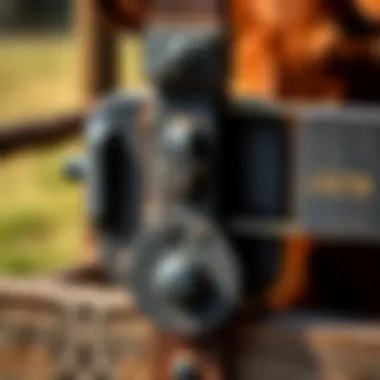

Intro
Livestock gate latches are an essential component of farm management, often overlooked yet crucial for ensuring the safety, security, and efficiency of livestock handling. These devices not only keep animals contained but also offer ease of access for farmers and caretakers. In a world where modern farming increasingly relies on technology and innovation, understanding the role of gate latches can't be understated. From preventing escapes to maintaining biosecurity, a well-chosen latch can make a significant difference.
Farmers and agricultural enthusiasts must familiarize themselves with the various types of livestock gate latches available on the market today. Understanding their functionalities, installation processes, and maintenance needs empowers those in the agricultural realm to make informed decisions that benefit their operations. As such, this article aims to explore these aspects in-depth, shedding light on considerations that can enhance farm security and management.
Crafting an effective setup starts with recognizing the different latch types, each designed for specific applications. The balance of sturdiness, usability, and security is vital, depending on the livestock being managed. Ultimately, the right latch contributes significantly to farm efficiency and animal welfare, paving the way for a smoother day-to-day operation.
Research and Data Analysis
As agricultural practices evolve, so too do the tools and mechanisms that support them. In this landscape, understanding current trends and utilizing data can lead to improved decision-making regarding livestock gate latches and their applications. Farmers should keep an eye out for emerging patterns that align with technological advancements.
- Latest Trends in Agriculture and Horticulture
The rise of automation and smart farming solutions highlights the integration of tech with traditional methods. For instance, some farmers are now utilizing electronic latches that can be operated remotely, allowing for improved access control. These innovations not only enhance security but also offer convenience in managing multiple entrances across expansive properties.
"It’s about leveraging technology to create a more efficient farming experience, ensuring that both security and accessibility are heightened."
- Statistical Insights into Livestock Management
The efficiency of livestock management can also be linked to the hardware being used. Research indicates that farms implementing robust gate latch systems experience up to a 30% decrease in escape-related incidents. This serves as a reminder—investing in quality latches is not just a matter of convenience but also a significant component of overall operational safety.
Best Practices and Techniques
To further understand the effectiveness of livestock gate latches, it's important to identify the practices that can elevate their use. Here, the focus shifts to integrating efficient strategies that can harmonize with these critical devices.
- Choosing the Right Latch for the Job
Selecting the appropriate latch is paramount. Options range from simple bolt latches perfect for gates with minimal traffic to more advanced options like drop pin latches that ensure maximum security for high-maintenance animals. Knowing your livestock and their behaviors will inform these choices. - Installation Methods
Proper installation simplifies functionality. Ensure that latches are mounted at an appropriate height and angle, promoting ease of access. If you're often using a single hand to manage the latch while handling feed or tools, consider latches designed for swift operation.
Pest and Disease Management
While livestock gate latches primarily focus on security, the importance of maintaining a pest-free environment cannot be ignored.
- Pest Control Strategies
Regular monitoring of gates and surrounding areas will help in minimizing any chances of infestations. Properly functioning latches that close securely can act as a barrier against rodents and other potential carriers of disease. - Integrated Pest Management Approaches
Implementing proactive measures, including regular checks on gate latches, supports a healthier environment for livestock. This approach combines preventive strategies that align with overall farm management goals.
As we dive deeper into each aspect of livestock gate latches throughout the following sections, the aim remains clear: to arm you with the knowledge needed to fortify your agricultural practices and safeguard your livestock effectively.
Foreword to Livestock Gate Latches
Livestock gate latches play a pivotal role in agricultural settings, providing not only a means to secure livestock, but also ensuring efficient farm management. Their functionality stretches beyond mere security; they contribute to the overall safety of both animals and farm workers. Without reliable latches, farmers might find themselves struggling against unexpected escapes or intrusions, which could result in significant setbacks.
Importance in Farming
In the dynamic world of agriculture, gate latches are akin to the unsung heroes of livestock management. When we think of farming, images of vast fields or bustling barns come to mind, yet the success of these facilities often hinges on the finer details, such as the latching mechanisms that hold gates secure. These latches not only safeguard against predators looking to harm cattle, but they also prevent livestock from wandering off into potentially hazardous areas, like roads or machinery zones. Given that farms are often vast and may require managing various types of livestock, efficient latches can streamline the daily tasks, allowing farmers to focus on other essential aspects of their operations.
The effectiveness of gate latches ties directly to historical practices in farming. For centuries, farmers have relied on various methods to secure their livestock, from rudimentary wooden posts to intricate mechanical designs. Each innovation reflects evolving agricultural practices and the unique challenges different environments pose. Today, with advancements in materials and technology, latches can be crafted to withstand harsh weather, frequent use, and, importantly, provide advanced features such as automatic locking mechanisms.
Historical Context
To fully appreciate the significance of livestock gate latches, it is beneficial to glance back at their history. Traditionally, farmers employed simple techniques made from wood, metal, or rope, depending on what was readily available at the time. During the early days of agriculture, security often relied on low-tech solutions where simple hooks or clamps served to keep gates closed. Local craftsmanship made these devices accessible, though their reliability varied.
With the advent of the Industrial Revolution, however, came a transformation in how gates were constructed and how latches operated. Mass production introduced more robust materials and standardized designs. It allowed farmers access to a wider array of latch mechanisms, facilitating innovations that significantly enhanced functionality and durability. Today, we can find everything from traditional slip latches to modern smart lock systems, each catering to the specific needs of livestock management in various agricultural systems.
Understanding the journey of gate latch development enriches one’s appreciation for the advancements we see today. These tools are now not only functional but also reflections of technological progress and shifts in agricultural practices, highlighting the importance of ongoing innovation in even the most fundamental aspects of farming.
Types of Livestock Gate Latches
When it comes to livestock management, the type of gate latch you choose can make all the difference. The right latch not only secures your gates but also influences the efficiency of operations on the farm. Understanding the various types of livestock gate latches can help farmers make informed decisions that enhance both security and ease of use. Here’s a closer look at the main categories of gate latches, emphasizing their unique attributes.
Slide Latches
Slide latches are among the simplest and most commonly used types in agricultural settings. Their design features a horizontal bar that slides into a bracket, securing the gate in place. One of the main advantages of slide latches is their straightforward operation; they can be easily opened and closed, even with one hand if designed accordingly. This is particularly useful when you have your hands full, perhaps carrying feed or tools.
Benefits:
- Ease of Installation: Generally, slide latches require minimal tools and are often found in DIY hardware kits.
- Cost-Effective: They are typically less expensive compared to more complex latch systems.
However, they do have their downside. In some cases, if not properly maintained, they might not keep the gate securely closed, especially when there’s strong wind or a determined animal pushing against the gate. It's essential to regularly check these latches to ensure they're functioning properly.
Spring-Loaded Latches
Spring-loaded latches provide a bit more hold than slide latches with their mechanism that automatically snaps into place when closed. This self-closing function is a real boon for busy farmers who might forget to secure the gate manually.
Advantages include:
- Self-Latching Feature: Once you close it, the latch automatically secures the gate, promoting livestock safety.
- Durability: Made often from robust materials, spring-loaded latches can withstand harsh weather conditions.
Despite their benefits, they can sometimes require adjustment over time to maintain effectiveness and may involve slightly more complex installation than other types.
Rotary Latches
Rotary latches work on a pivoting mechanism that securely locks gates into a fixed position. This style is favored in larger farming operations where gates are frequently opened and closed. When pulling the latch handle, a closing action occurs, allowing quick access while maintaining security when closed.
Key features:
- Secure Locking Mechanism: They provide a reliable closure, which is crucial for containing livestock.
- Versatile Applications: Can be found on larger barn doors or vehicle gates as well as livestock enclosures.
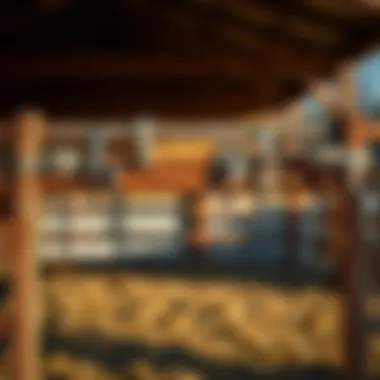

While their operation can be slightly more complicated than that of simpler latches, once the user gets the hang of it, rotary latches are efficient and effective.
Deadbolts
Deadbolts are the heavy artillery when it comes to gate security. If you have a location that requires heightened security, you can't go wrong with a deadbolt latch. These latches engage with a bolt that extends into a receiving doorframe, making it nearly impossible to bypass. They require a key or a thumb turn to unlock, adding an additional layer of security against potential threats.
Considerations for deadbolts:
- Enhanced Security: Provides excellent protection against unwanted intrusions.
- User Complexity: May require a key or specified unlock method that can be a hassle if you’re in a hurry.
If you're handling high-value livestock or have sensitive equipment that needs safeguarding, investing in quality deadbolt latches is wise.
Self-Latching Mechanisms
These mechanisms have caught on in modern livestock management as they provide a convenient balance between functionality and security. Self-latching systems typically involve a spring-loaded or gravity-operated latch that automatically secures the gate when closed. This design is particularly effective for gates in high-traffic areas.
Benefits of self-latching systems:
- Convenience: These systems are excellent for farmers who often need both hands free.
- Energy Efficiency: By combining ease of use with reliability, they reduce the risk of human error, ensuring the gate is secured without extra effort.
However, regular maintenance is key to ensure that debris or rust doesn't hinder their effectiveness, especially in outdoor settings where they may be exposed to harsh weather conditions.
Choosing the right type of livestock gate latch can significantly affect both your livestock welfare and the operational efficiency of your farm.
Understanding the nuances of each latch type helps pave the way for improved management strategies that cater to your specific farming needs. So, selecting the appropriate latch extends beyond mere functionality; it is about securing the well-being of both your animals and your agricultural investments.
Materials Used in Gate Latches
When it comes to the effective operation and durability of livestock gate latches, the material from which they are crafted holds significant importance. Choosing the right material not only impacts the longevity and security of the latch but also influences its functionality across different environments. Factors like weather resistance, maintenance needs, and overall cost must be taken into account. Here, we delve into the various materials commonly utilized in the making of gate latches – metal alloys, plastics and composites, and wood – uncovering their unique properties and advantages.
Metal Alloys
Metal alloys are typically favored for their strength and resilience, making them a go-to choice for many farmers overseeing livestock. The combination of various metals leads to enhanced corrosion resistance, which is crucial in outdoor settings where rain and moisture are frequent.
Some common alloys include stainless steel and galvanized steel. Stainless steel, for example, is well known for its resistance to rust, which means it can withstand the elements without compromising its structural integrity. Galvanized steel, having been treated with a protective coating, offers a budget-friendly option without sacrificing durability.
Metal latches, while robust, may require periodic maintenance, particularly if exposed to harsh conditions. Proper care helps avoid issues like rust and sticking, ensuring smooth operation. It's worth mentioning that a latch made from quality metal alloy can withstand significant wear and tear, thus translating to fewer replacements over the years.
Plastics and Composites
On the other hand, plastics and composites have gained traction in the agricultural sector for their lightweight nature and resistance to corrosion. Unlike metal, these materials don't rust; hence, they can offer a long-term solution at often lower costs. Materials like polyethylene and nylon can handle diverse environments, making them suitable for various applications.
One advantage of using plastics is their flexibility. They can be molded into intricate designs, allowing for easier assembly and installation. However, they might not always match the strength of metals in high-stress conditions. It is vital to assess the specific needs of your farm – whether weight, ease of handling, or durability is a priority. In some cases, composite materials that combine the benefits of both plastics and metals might also be an option worth considering.
Wood Components
Though less common in modern latches, wood can still be found in some traditional gate latch designs. Wooden components can add an aesthetic appeal, offering a rustic charm that many farmers appreciate. However, wood lacks the durability and security that metals and modern composites provide. It is susceptible to rot, warping, and insect damage, which can lead to inefficiencies in functionality over time.
That said, wood latches can be a viable option in certain contexts, particularly for light-use applications or decorative purposes. When using wood, it's essential to treat it well to mitigate potential weather-related issues. And after all, a traditional wooden latch can evoke a sense of nostalgia among those who value heritage in farming practices.
Choosing the right material for your livestock gate latch can significantly affect its performance and lifespan. Always balance the need for strength, maintenance, and aesthetic appeal, based on your specific requirements.
In summary, metal alloys, plastics, composites, and wood each have their own sets of benefits and drawbacks. Understanding these materials is crucial for making an informed decision that aligns with your operational needs and budget. Evaluating your unique situation, including the specific gate conditions and frequency of use, can lead you to the most suitable selection that serves your farm well.
Functional Attributes of Gate Latches
When discussing livestock gate latches, their functional attributes play a pivotal role in ensuring that these systems serve their intended purposes efficiently. Not only do they enhance the usability and reliability of gates on farms, but they also ensure the safety and security of livestock and property. There are several key elements to consider in understanding how these functional attributes contribute to the effectiveness of gate latches.
Durability
The toughness of a latch can make all the difference in agricultural settings. Farm life is often demanding, and the equipment used must withstand a barrage of environmental challenges, from heavy rain to extreme heat. Durability in livestock gate latches primarily comes from the materials used in their construction. For instance, latches made from stainless steel or reinforced alloys tend to endure better than those crafted from plastic.
- Weather Resistance: Good latches resist corrosion, a vital attribute considering the often humid farm environment.
- Impact Resistance: A strong latch can survive accidental bumps or knocks from vehicles or animals, which is an everyday occurrence on farms.
Reliable latches do not just save money on replacements; they also prevent potential accidents that could occur if livestock escape due to a faulty latch. In terms of investment, opting for durable materials can spell the difference between a cost-effective choice and persistent problems.
Ease of Use
Simplicity is essential when dealing with any machinery on a farm, especially in demanding situations. A latch should operate smoothly without requiring excessive effort. When hands are full—be it carrying feed or managing tools—struggling with a complicated latch can lead to frustration and inefficiency.
- User-Friendly Design: Many modern latches focus on intuitive designs that allow farmers to operate them with minimal fuss. For example, a slide latch mechanism can be frictionless and requires only a gentle pull to secure or release.
- Accessibility: Height and placement of latches matter; they should be reachable for the average person, even when managing livestock or equipment nearby.
Importantly, ease of use directly relates to safety. A gate latch that’s too complex or hard to operate can lead to accidents—not just for farmers but for the livestock as well. Having latches that are simple to handle can significantly reduce the risk of mishaps in crucial moments.
Security Features
In today's world, security is paramount. Livestock is often one of the largest investments a farmer makes, and ensuring their safety is crucial. Effective livestock gate latches incorporate security features that prevent unauthorized access.
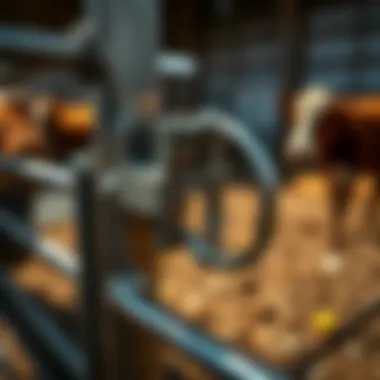
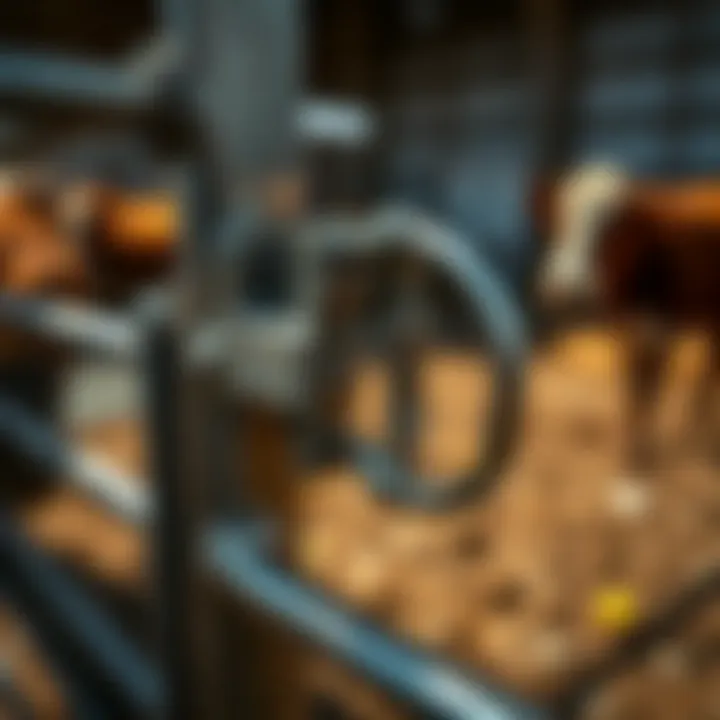
- Locking Mechanisms: Some latches come equipped with locks that require a key or a combination to open. This feature is especially significant in areas prone to theft.
- Self-Locking Designs: Certain models will automatically secure themselves when a gate is closed. This is beneficial as it guards against forgetfulness—an essential consideration when managing numerous gates.
Moreover, strong visual deterrents can discourage potential intruders before they even attempt to breach a gate. A latch that visibly conveys strength and security can provide peace of mind.
"When the latch is solid and works like a charm, the peace of mind it gives you is worth its weight in gold."
Installation Considerations
When it comes to livestock gate latches, ensuring a proper installation is just as crucial as choosing the right latch itself. Without a solid installation, even the best latch can fail, leading to security issues or unwanted access to pasture areas. This segment touches on the essentials of getting the installation right, highlighting elements that can make or break your efforts.
Site Preparation
Before diving into the actual installation, preparing the site can save you quite a bit of heartache later on. Start by assessing the location where the latch will be installed.
- Choosing the Right Location: Verify that the gate is level and can swing freely. It might seem trivial, but irregular terrain can hinder functionality.
- Clearing Debris: Remove any rocks, weeds, or other obstructions from the area around the gate. This step ensures that you have a clean workspace and avoids snapping or bending latches unexpectedly.
- Measuring Correctly: Proper measurements help in ensuring that the latch aligns well with the catch. Take your time – a small misalignment can cause issues down the line.
By taking these simple preparatory steps, you set the stage for a smooth installation thanks to the generous attention given to your work environment.
Tools Required
Having the right tools makes the difference between a frustrating experience and a task well done. Below is a list of tools you might need:
- Drill: A power drill is essential for making holes in the gate and posts.
- Screwdriver: Having a good-quality screwdriver will aid in securing the latch.
- Measuring Tape: Accurate measurements are key to get the latch positioned correctly.
- Level: To ensure your installation is balanced, a level will come in handy.
- Wrench: Some latches require nuts and bolts, so have a wrench at the ready.
With these tools in hand, you're well-equipped for the job.
Step-by-Step Installation Guide
Installing a livestock gate latch involves a few straightforward steps that can be easily followed. Here’s a concise guide:
- Mark the Installation Points: Using your measuring tape, mark where the latch will go on both the gate and the post.
- Drill Holes: Carefully drill holes at the marked locations. Use the appropriate drill bit size that matches the latch hardware so you get a snug fit.
- Attach the Latch: Position the latch over the drilled holes and start fixing it with screws or bolts, depending on what the latch requires. Make sure it’s flush with the surface of the gate.
- Install the Catch: Install the catch on the post, making sure it aligns perfectly with the latch on the gate.
- Test the Mechanism: Before considering the job done, open and close the gate a few times to ensure everything functions correctly. Adjust as necessary until you achieve smooth operation.
Following these steps closely will ensure your livestock gate latch is securely installed and ready for action.
"A well-installed latch can be the difference between a boisterous barn and a secure home for your livestock."
By minding these installation considerations, you not only aim for performance but also for longevity with the latches you choose. Whether securing livestock or protecting crops, every bit of attention you put into this installation site can pay off significantly in the end.
Maintenance of Livestock Gate Latches
Keeping livestock gate latches in tip-top shape is more than just a matter of convenience—it’s essential for ensuring security and functionality in your agricultural operations. Latches play a critical role in managing livestock and protecting crops, so their upkeep shouldn’t be taken lightly. Regular maintenance can save you time, money, and headaches down the line. Let’s break down what’s involved in maintaining these vital components, focusing on inspections, lubrication, and troubleshooting common issues.
Routine Inspections
Routine inspections are the backbone of effective maintenance for livestock gate latches. Incorporating a systematic approach can help catch wear and tear before it spirals into bigger problems. Here are a few key aspects to consider during inspections:
- Visual Checks: Always start with a keen eye. Look for rust on metal parts, cracks in plastics, or warping in wooden components that could compromise the latch's integrity.
- Functionality Test: Open and close the latch multiple times. It should operate smoothly without sticking or jamming. Sometimes a few moments of observation can reveal more than you might think.
- Tightness of Hardware: Ensure all screws, bolts, and nuts are tight. Loose hardware can lead to misalignment, which might affect how securely the latch functions.
- Environmental Impact: Depending on your region, certain weather conditions can affect the longevity of latches. For instance, salt from coastal winds might prompt more frequent checks.
Regular inspections can prevent many functional failures and help extend the lifespan of your latches.
Lubrication Techniques
Lubrication is another crucial aspect of maintaining livestock gate latches. Proper lubrication minimizes friction and keeps your latches moving freely while also protecting against rust. Here are a few tips for effective lubrication:
- Choosing the Right Lubricant: It’s best to use a waterproof lubricant rather than oil, which can attract dirt and create grime. Silicone spray or graphite powder is often recommended. They do not attract dust and can last quite a bit longer.
- Application Method: Apply the lubricant to all moving parts and joints. A little goes a long way—too much can create sludge that attracts dirt, whereas too little won’t adequately reduce friction.
- Frequency of Lubrication: Depending on weather conditions and usage frequency, a good rule of thumb is to lubricate every two to three months. During heavy usage or adverse weather, you may want to increase this frequency.
Regularly lubricating your latches can prevent unnecessary wear and tear and keep them functioning seamlessly.
Troubleshooting Common Issues
Even with routine maintenance, you may encounter some issues with your livestock gate latches. Knowing how to troubleshoot these problems can save you time and money:
- Sticking or Jammed Latches: If the latch isn’t moving freely, check for dirt or debris accumulation. A good cleaning might be all that’s needed. If that doesn’t work, it may be an issue with the alignment.
- Misalignment Problems: If it appears misaligned, check the fittings and adjust as necessary. Sometimes, a simple tightening is enough to straighten things out.
- Rusty Parts: If you find rust, do not panic. You can typically grind it off using sandpaper and then apply lubricant to protect against future corrosion.
- Broken Components: If a part is broken beyond repair, it’s often cheaper to replace the latch than try to fix it. Ensure you have compatible replacement parts ready for when the need arises.
By investing the time in routine inspections, proper lubrication, and troubleshooting, farmers can ensure their livestock gate latches remain effective and reliable. This vigilance not only enhances livestock management but also fortifies security on the farm.
Innovations in livestock gate latch design
In today’s fast-paced agricultural landscape, advancements in livestock gate latch design are not simply beneficial, they are crucial. With the ongoing emphasis on efficiency and security in farming, innovations play a pivotal role in meeting the demands of modern agriculture. New latch technologies not only aim to improve functionality but also address concerns related to durability, user-friendliness, and environmental impact.
Smart Latching Systems
Smart latching systems are revolutionizing how farmers secure their livestock and property. These innovative latches often incorporate technology such as remote controls or smartphone applications, allowing farmers to monitor and control access points from a distance. This tech-savvy approach ensures that producers can manage their livestock without physically being present at every gate.
The advantages of these smart systems are manifold. For one, they enhance security. A well-designed smart latch can alert farmers about attempts of unauthorized entry. The integration of sensors can detect openings and closings, providing real-time data that not only helps in managing livestock better but also adds a layer of protection against theft or accidents.
Moreover, smart latching systems can offer functionality that reduces physical exertion for farmers. Individuals with mobility issues, or those with a busy schedule, can benefit immensely from these systems. Instead of wrestling with tricky latches, they can operate these devices with ease.
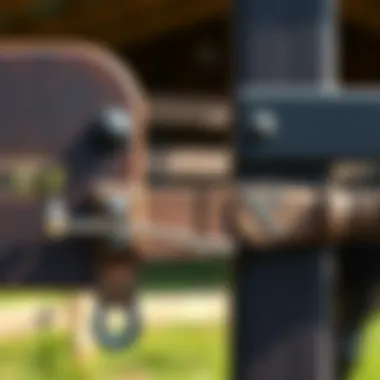
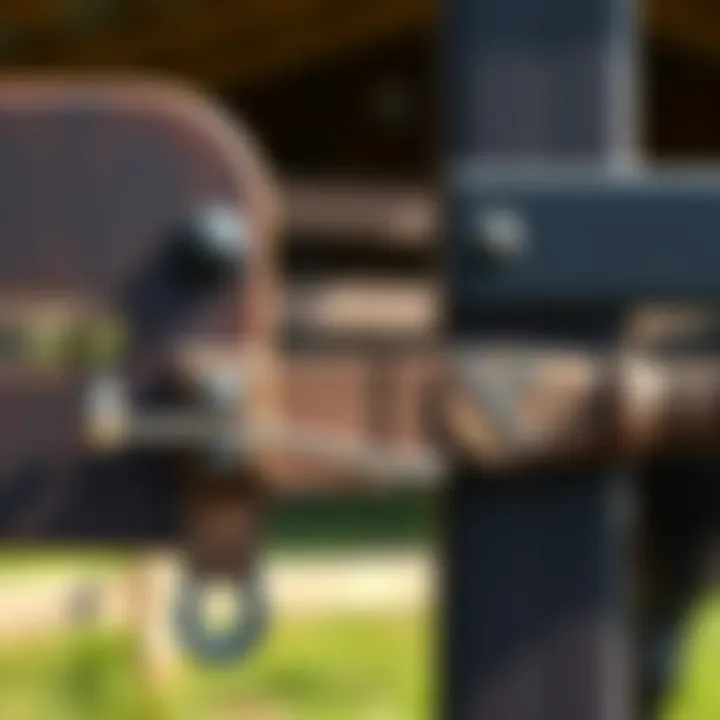
Some things to keep in mind when integrating smart latching systems include:
- Cost considerations: Initial setup might be higher compared to traditional latches.
- Maintenance needs: Electronics can fail in adverse conditions; thus, understanding the environment is crucial.
- Learning curve: As with any new technology, there can be an adjustment period for farmers.
Sustainable Materials
As sustainability takes center stage in the farming industry, the move towards eco-friendly materials in livestock gate latches becomes increasingly important. Traditional materials such as metals have their place but using bio-based or recycled composites can significantly decrease the environmental footprint of these products.
Adopting sustainable materials presents an opportunity for farmers to embrace greener practices. For instance, latches made from recycled plastics or natural composites can be just as durable and effective as their traditional counterparts but with reduced emissions during production. Benefits of choosing sustainable materials include:
- Lower environmental impact: These materials can help minimize plastic and metal waste.
- Long-term savings: Many sustainable options offer longer life spans, leading to fewer replacements and reduced costs.
- Marketability: Eco-friendly practices can attract customers who prioritize sustainability in their purchasing decisions.
When considering sustainable latches, farmers should evaluate:
- Durability: Ensuring that sustainable options can withstand weather and wear.
- Availability: The need to source these materials locally to ensure supply.
- Compatibility: Making sure that the new materials fit seamlessly with existing systems.
"The future of farming lies in the hands of those willing to adapt and innovate."
For more detailed discussions on agricultural tools and practices, you may refer to resources such as Wikipedia or insights available on Reddit for further community input.
Applications in Modern Agriculture
In the realm of modern agriculture, the role of livestock gate latches extends beyond mere functionality. These devices are vital in ensuring that the day-to-day operations of a farm run smoothly, secure, and efficiently. Livestock gate latches serve as the first line of defence against potential escapes or breaches, ultimately safeguarding both animals and crops. Understanding their applications can lead farmers to enhance productivity and protect their investments.
Livestock Management
Efficient livestock management hinges on being able to control access to various areas of a farm. Latches that secure gates are crucial in this regard. Here’s how they assist in livestock management:
- Control of Movement: Proper latching systems help in guiding livestock movements. For example, on a cattle farm, being able to secure a pasture gate prevents animals from straying into crop fields or off the property entirely.
- Health Monitoring: Latches that are easy to operate allow workers to quickly access animals for health checks or feeding, which is vital in maintaining overall herd health.
- Reduced Risk of Injury: A good latch system ensures that animals cannot accidentally open gates, reducing the risk of injury not just to the livestock but also to farmworkers.
- Improved Workflow: Well-designed latches facilitate the efficient movement of livestock from one pen to another, which is essential during milking or veterinary procedures. This minimizes stress both for the animals and the handlers.
In essence, the implementation of reliable latches significantly reduces the potential for chaos and accidents, creating a more controlled environment for livestock management.
Crop Protection
While livestock management takes up a significant part of a farm’s focus, crop protection is another vital consideration where gate latches play an integral role. Here’s why:
- Preventing Damage: Gates equipped with secure latches keep livestock, intruders, and even wild animals from accessing and damaging crop fields. This boosts crop yield and preserves the integrity of the farmland.
- Pest Control: In conjunction with fencing, latches help to secure areas against common pests. Access to specific crops can be restricted, helping to prevent unwanted animals from damaging plants.
- Specified Access: Farmers may choose to restrict access to certain fields during different periods of the crop-growing cycle. Quality latches contribute to this by providing a reliable way to manage which areas are open or closed on the farm.
The ability to confidently secure crop fields with reliable latches means that farmers can focus more on cultivation rather than continuously worrying about potential breaches.
As agriculture continues to evolve, understanding the practical applications of devices like gate latches becomes more than just beneficial; it is essential for sustainable farming practices.
In summary, livestock gate latches are not merely tools for closure; they are critical components in the broader landscape of agricultural management. Their role in livestock management ensures animal health and safety, while their importance in crop protection secures farmland against damage. Recognizing this dual role is key to enhancing productivity and sustainability in modern agriculture.
Case Studies of Effective Use
The practical application of livestock gate latches can often be illustrated through the analysis of real-life scenarios. Understanding how different farms leverage these devices for enhanced functionality not only highlights the importance of these latches but also serves as an essential learning tool for future improvements. By examining specific case studies, farmers can see firsthand the tangible benefits that various latch types offer, such as increased security, improved access, and overall more efficient farm management.
Each case study stands as a testament to how thoughtful implementation of gate latches can lead to remarkable improvements on the farm. Below are two exemplary scenarios that illuminate key aspects of livestock gate latch effectiveness.
Farm A: Enhanced Security
Farm A showcases an inspiring example of security enhancement through the strategic installation of deadbolts and rotary latches. Located in a rural area where livestock theft is a threat, the farm's owner decided to upgrade their existing gate latching system to mitigate the risk of unauthorized access.
By replacing traditional latches with heavy-duty deadbolts, the farm was able to create a more robust barrier. These deadbolts are known for their resistance against tampering, offering peace of mind to the farm owner, who noted a significant reduction in security breaches. The switch to a rotary latch system further complemented the deadbolts, providing both a reliable locking mechanism and user-friendly operation for daily access.
"Investing in a quality latch system was a game changer for us. We can now leave the farm with confidence, knowing it’s secure."
- Farmer A, Owner of Farm A
The financial outlay on the upgraded latching system was quickly offset by the decrease in theft incidents. Additionally, the tough metal alloys used in the construction of these latches proved to be remarkably long-lasting, minimizing future replacement costs. In this case, the decision to enhance security has not only protected valuable livestock but has also had a positive impact on the farm's overall efficiency.
Farm B: Improved Access
Farm B serves as another fine example, demonstrating how improved access through smart latch technology can streamline farm operations. The owner implemented a combination of self-latching mechanisms and spring-loaded latches. These devices enable gates to close automatically after passage, which is particularly advantageous in a busy agricultural environment.
Before the installation of these smart latches, workers frequently faced issues where gates were left ajar, culminating in potential escapes or injuries to livestock. Now, with the enhanced design in place, farm workers report noticeable time savings during daily rounds.
Furthermore, these latches are designed for easy operation, requiring minimal physical effort, thus reducing fatigue among staff—an important consideration in any agricultural setting. The self-latching feature is not just a convenience; it dramatically decreases the risk of leaving gates unsecured. Improved accessibility has led to better workflow on the farm, leaving the owner with more time to focus on other pressing matters.
In summary, effective use of livestock gate latches, as seen in Farms A and B, illustrates the potential improvements that can be achieved through thoughtful application and technology. These case studies highlight the benefits of enhanced security measures and accessibility in modern agricultural practices.
Finale
In reflecting on the complexities and benefits of livestock gate latches, it’s clear that these seemingly simple devices play a multifaceted role in modern agriculture. They are not just functional tools; they embody an essential element of farm management, contributing perhaps more than one might initially assume. Ensuring secure and manageable access is foundational to effective livestock and crop management, thus enhancing overall operational efficiency.
Future Trends in Gate Latch Technology
As we peer into the horizon of agricultural technology, several trends are emerging in gate latch development that are poised to redefine security and accessibility on farms.
- Smart Latching Systems: Integration of IoT technology into gate latches allows for remote access control, monitoring, and notifications. This means farmers can lock or unlock gates from anywhere, ensuring safety even when they are not physically present.
- Sustainable Materials: There's a growing emphasis on using eco-friendly and durable materials in the manufacturing process. Innovations in bioplastics and recycled metals could offer both sustainability and longevity, making these products appealing to environmentally conscious farmers.
- Enhanced Security Features: The introduction of biometric systems for gate access could ensure that only authorized personnel can interact with livestock gates. This could significantly curb unauthorized access or theft on farms.
- User-Centric Design: Future designs will likely focus more on the user's experience. Making gate latches more intuitive and easier to operate will become a priority, especially for those working in challenging conditions or hostile weather.
- Data Integration: The ability to collect data regarding gate usage can help farmers understand patterns, optimizing how and when gates are used. This data can feed into larger farm management systems for enhanced productivity.
Understanding these trends is crucial for farmers and agricultural enthusiasts keen on staying ahead of the curve. By embracing these innovations, it is possible to enhance farm security and accessibility, leading to improved overall efficiency.















